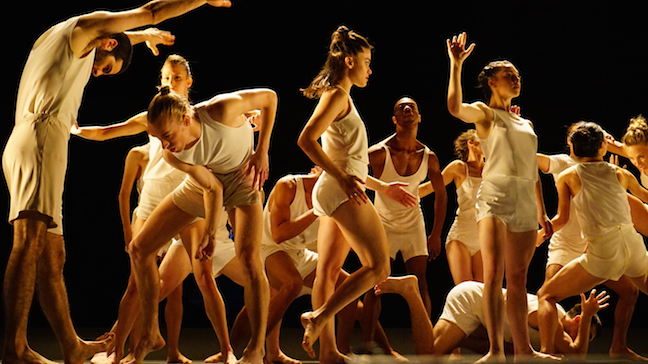
Imagine Hieronymus Bosch’s Garden of Earthly Delights – an effusive and detailed landscape filled with cavorting naked humans, one wearing a single enormous blossom as a hat, and whimsical creatures part animal, part human, part exotic flower. Now imagine those very material creatures reconceived as movement: an enigmatic gesture of sustained slowness, perhaps, interrupted by a sudden quixotic isolation. Or, knees turned impossibly inward as a crouching dancer moves slowly across the stage. Or, heads jutting and retracting quickly like that of a snake.
Imagine strange movements that suggest otherworldliness, and you might come close to imagining the choreography in Ohad Naharin’s Last Work, which was presented by San Francisco Performances in three days of performances at the Yerba Buena Center for the Arts.
Batsheva Dance Company is a Tel Aviv–based dance troupe, which was founded in 1964 by the Baroness Batsheva de Rothschild. Martha Graham was its first artistic advisor.
Naharin began dancing at the company in 1974, and was enlisted by Graham to dance in her New York company. In 1990 he took over as artistic director of Batsheva Dance Company.
During his tenure, Naharin has built an unusual dance style, based on what he calls gaga. Rather than repeat or modify an established dance vocabulary, like the very set steps devised by the autocratic Graham, gaga requires the dancers to “listen to the body” and to follow its impulses. Hours are spent in class with each dancer moving to their inner voice. The result is something weird and wonderful.
Naharin describes the process as mixing things as if in a blender, so that the elements that went into the mix are not readily discernible in the end result. He also emphasizes small details, believing that “very delicate stuff can become wow.”
Last work begins with a solitary woman in a blue dress running on a treadmill upstage. She never falters in her pace, but sets a kind of rhythm for the piece, like the tick of a clock’s second hand. At times when the mostly electronic music falls away, all that is heard is the beat of her feet striking against the floor.
A man in dark colored shorts and shirt walks across the stage, crouched, moving crab-like. The floor is an essential, many of the dancers crawling and scuttling, but in deliberate and sustained ways so that the movement becomes recognizable as dance, as expressive gesture. Bodies undulate, and legs extend, slightly skewed so that the dancer seems always on the point of change, of collapse, of falling. Repetitions in movement become staccato.
Finally, everyone is on the floor under a faintly bluish light, which gives their pale legs an ethereal quality. But there is also something sensual about the dancers’ skin. It’s a contradiction, a sensory confusion that is unresolvable.
And the woman in blue continues to run….
In the second part of the piece, the dancers line up and change into silky looking white shorts and tops. Several men put on long dark robes, resembling clerics. One woman wears a tiny white tutu. While the dancers sit in a line as if waiting for an audition, pairs of dancers stand and perform in synchronous movement. Bodies entwine. Hands are raised, or offered palm up.
The dancers shift again into a third movement that is more easily read as symbolic. A man with his back to the audience is polishing a gun, and there is something disturbingly sexual in his movements. Another man turns an oversized noise-maker. The woman in blue is now carrying a flag while she runs, a second dancer holding out the white rectangle of cloth as if it were blowing in the breeze. The shift to “readable” symbols, or acts, is a little disconcerting in the context of the other two parts of the dance, it’s as if an abstract expressionist painter suddenly began painting representational potraits.
It’s all puzzling and compelling, and the dancers are, without exception, superlative. The whole creating a fascinating and mind-bending look at the human body and the extent of its expressive power.
– Jaime Robles
Photo: Batsheva Dance Company. Photo by Gadi Dagon.
